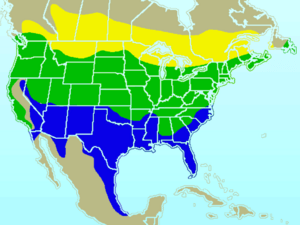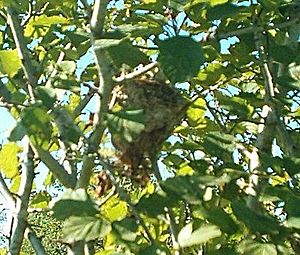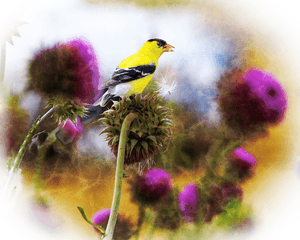American goldfinch facts for kids
Quick facts for kids American goldfinch |
|
|---|---|
 |
|
| Male American goldfinch in spring plumage | |
| Conservation status | |
| Scientific classification | |
| Genus: |
Spinus
|
| Species: |
tristis
|
| Subspecies | |
|
|
 |
|
| Breeding range Year-round range Wintering range | |
| Synonyms | |
|
|
The American Goldfinch (Spinus tristis) is a small, bright bird found in North America. It is part of the finch family. These birds are migratory, meaning they fly long distances. They spend their summers from Alberta to North Carolina. In winter, they fly south, from the Canada-United States border down to Mexico.
This finch is unique because it changes all its feathers twice a year. Male and female goldfinches look different, especially in summer. Males are a bright yellow in summer and turn olive green in winter. Females are a duller yellow-brown color, which gets only a little brighter in summer. The male's bright summer feathers help him attract a mate.
American Goldfinches mostly eat seeds. Their cone-shaped beak helps them remove seeds from plants. Their agile feet let them hold onto plant stems while they eat. They also enjoy eating garden plants like beet greens. These birds are social and often gather in large groups. They flock together when feeding and when migrating. While building their nests, they might act a bit territorial, but this doesn't last long. They start their breeding season in late July. This is quite late for a finch, but it matches when their favorite seeds are most available. Goldfinches usually have one mate and raise one group of babies each year.
Humans have actually helped the American Goldfinch. These birds often visit backyard bird feeders, which helps them survive. Also, when forests are cleared, it creates open meadows. These open areas are the goldfinch's favorite places to live.
Contents
About the American Goldfinch Name
The famous scientist Carl Linnaeus first described the American Goldfinch in 1758. He included it in his important book, Systema Naturae. The bird was first placed in the Spinus group, which includes New World goldfinches and siskins. Later, in 1976, Spinus was combined with the Carduelis group. However, newer studies have brought back the Spinus group for these birds.
The American Goldfinch's closest relatives are the lesser goldfinch, Lawrence's Goldfinch, and siskins. Even though it shares a name with the European goldfinch, they are not closely related. The name Carduelis comes from a Latin word for 'thistle'. The species name tristis means 'sorrowful' in Latin.
Different Types of American Goldfinches
There are four known types, or subspecies, of the American Goldfinch:
- The eastern goldfinch (S. t. tristis) is the most common type. It lives from southern Canada to Colorado and east to the Carolinas in summer. In winter, it moves south to Florida and central Mexico.
- The pale goldfinch (S. t. pallidus) has lighter body colors and more white markings. Males of this type have a larger black cap on their heads. It is a bit bigger than the eastern goldfinch. Its summer home is from British Columbia to western Ontario, south to Colorado and west to Oregon. In winter, it ranges from southern Canada and northern California down to Mexico.
- The northwestern goldfinch (S. t. jewetti) is smaller and darker than the other types. It lives along the coast of the Cascade Mountains, from southern British Columbia to central California.
- The willow goldfinch (S. t. salicamans) lives west of the Sierra Nevada mountains in summer. In winter, it moves to central and southern Baja California and the Mojave and Colorado Deserts. In winter, both male and female willow goldfinches are browner. In summer, the male's black cap is smaller than other types.
Appearance and Features
The American Goldfinch is a small finch. It is about 11 to 14 centimeters (4.3 to 5.5 inches) long. Its wingspan is about 19 to 22 centimeters (7.5 to 8.7 inches). It weighs between 11 and 20 grams (0.39 to 0.71 ounces). Its beak is small and cone-shaped. It is pink for most of the year. But in spring, it turns bright orange for both males and females.
The shape and size of their beak are perfect for getting seeds. They can easily pull seeds from thistles, sunflowers, and other plants.
Feather Changes (Molting)
The American Goldfinch changes its feathers, or molts, twice a year. This happens in spring and autumn. It's the only finch of its kind to molt all its feathers twice a year. During the winter molt, it sheds all its feathers. In spring, it sheds all but its wing and tail feathers. These feathers are dark brown on females and black on males. The markings on these feathers stay the same through each molt. They have bars on their wings and white under and at the edges of their short, notched tail.
The difference in feather colors between males and females is very clear after the spring molt. This is when the male's bright summer colors are needed to attract a mate.
After the spring molt, the male's body is a bright lemon yellow. This color comes from pigments in the plants he eats. He also has a striking black cap and a white rump that you can see when he flies. The female is mostly brown, lighter underneath, with a yellow patch on her chest. After the autumn molt, their bright summer feathers are replaced by duller ones. They become buff-colored underneath and olive-brown on top. Their face and chest are pale yellow. The autumn feathers look almost the same for both sexes. However, the male still has yellow patches on his shoulders. In some cold winter areas, goldfinches might lose all their yellow color. They become mostly a medium tan-gray. You can only see an olive tint if you look very closely.
Young American Goldfinches have a dull brown back. Their underside is pale yellow. Their shoulders and tail are dull black. They have buff-colored markings on their wings and rump, not white ones. This coloring is the same for both young males and females.
Sounds and Calls
The American Goldfinch's song is a series of musical warbles and twitters. It often includes a long note. They make a "tsee-tsi-tsi-tsit" call when flying. Some people describe it as "per-chic-o-ree." While the female sits on the eggs, she calls to her mate with a soft, continuous "teeteeteeteete" sound. Young birds start making a "chick-kee" or "chick-wee" call just before they leave the nest. They use this call until they are fully independent.
Adults make two defense calls when nesting. A "sweet" call brings other goldfinches to the nest to distract predators. A "bearbee" call tells the nestlings to be quiet and crouch down. This makes them harder to see.
Where Goldfinches Live (Distribution and Habitat)
The American Goldfinch likes open areas where weeds grow well. These include fields, meadows, and floodplains. They also live along roadsides, in orchards, and gardens. You can also find them in open forests with deciduous trees and along rivers. They like areas where new trees are growing. They prefer these same habitats during their spring and autumn migrations.
Their summer breeding range covers North America from coast to coast. It goes from Saskatchewan in the north, south to North Carolina on the east coast, and northern California on the west coast. The American Goldfinch is a short-distance migrant. It moves south when the weather gets colder and food becomes scarce. They migrate in tight flocks, flying in a wavy, up-and-down pattern.
Their winter home includes southern Canada and stretches south through the United States into parts of Mexico. In winter, in colder northern areas, they might move closer to bird feeders if available. In warmer southern areas, they stay in places like the fields and floodplains where they live in summer.
People tried to bring American Goldfinches to Bermuda in the 1800s and Tahiti in 1938. But the birds did not manage to settle and live there.
Goldfinch Behavior
The American Goldfinch has a special way of flying. It flies in an up-and-down, wavy pattern. It flaps its wings to go up, then folds them in and glides down in an arc. Then it repeats the pattern. Birds often make sounds when they flap their wings. They go silent when they glide. The call they make while flying is "per-twee-twee-twee" or "ti-di-di-di."
American Goldfinches do not act aggressively towards predators near their nests. They only make alarm calls. Predators include snakes, weasels, squirrels, and blue jays. These animals might destroy eggs or kill young birds. Hawks and cats are a danger to both young and adult goldfinches. The oldest known American Goldfinch lived to be 10 years and 5 months old.
Social Life
When it's not breeding season, American Goldfinches are very social. They often gather in large flocks, usually with other finches. In these flocks, males tend to be more dominant than females. During breeding season, these finches live in loose groups. While building the nest, the male will chase away other males who come into his area. The female does the same to other females. This aggressive behavior stops once the eggs are laid. During breeding season, the female is usually dominant over the male. Sometimes, a very hungry bird that is usually lower in rank might become dominant when competing for food at a feeder.
American Goldfinches show how aggressive they are in different ways.
- A "head-up" display, with the neck and legs slightly stretched, shows mild aggression. The bird who wins an encounter often does this.
- In the "carpals-raised" display, the neck is pulled back and the "wrists" (carpals) are raised. Birds doing this are likely to attack.
- The "head-forward" display involves bent legs, a stretched neck, and a closed beak. If they are more aggressive, the neck is lowered, the beak points at the opponent, and one or both wings are raised.
- In extreme cases, the neck is pulled back, the beak is open, body feathers are smoothed, and the tail is fanned and slightly raised.
- They also show aggression by turning the front of their body towards another bird.
- Attacks include pecking feathers, landing next to an opponent to make them move, and flying straight up with legs and feet out, beaks open, and necks stretched.
- To avoid a fight, they might show only the side of their body, lean away, bend their legs, pull their neck back, and point their beak down.
Reproduction and Life Cycle
The American Goldfinch starts its breeding season later than any other finch. It's also later than most other native North American birds. This is probably because they rely on seeds for food. Seeds are most plentiful in late summer.
Male goldfinches start their courtship rituals in late July. These include flying in special ways and singing. The male chases the female, who flies in zig-zag patterns to avoid him. The male shows how strong and healthy he is through his bright beak color and feathers. If the female accepts him, they will fly in wide circles together. The male will sing throughout the flight.
Once a male finds a mate, he picks a territory. He marks its edges by singing as he flies from perch to perch. After flying around the area, he performs two flight displays. First, he flies low and flat. Then, he flies in an exaggerated way, tucking his wings close to his body. He plummets towards the ground, then catches himself. He spreads his wings to glide upward in a series of loops. Two or three pairs might nest close together in a loose group. This might help them defend against predators.
The female builds the nest in late summer. She places it in the branches of a leafy shrub or tree, up to 10 meters (33 feet) high. Building the nest takes about six days. The female works for 10 to 40 minutes at a time. The male often flies with the female as she gathers materials. He might carry some materials back, but the female does all the building. The outside of the nest is made of bark, weeds, vines, and grass. The inside of the finished nest is about 6.5 centimeters (2.6 inches) across. The rim is strengthened with bark held together by spiderwebs and caterpillar silk. The inside is lined with soft plant fluff from milkweed, thistle, or cattail. The nest is so tightly woven that it can hold water. If it rains heavily, the baby birds could drown if the parents don't cover the nest.
The American Goldfinch lays four to six bluish-white eggs. They are oval-shaped, about 16 by 12 millimeters (0.63 by 0.47 inches), roughly the size of a peanut. They are thought to be laid at night. Only the female sits on the eggs to keep them warm. The male brings her food while she nests. Most pairs raise only one group of babies each year.
The chicks hatch 12 to 14 days after the female starts sitting on the eggs. Like all perching birds, the chicks are born helpless. They hatch naked, with reddish bodies, pale gray fuzz, and closed eyes. The mother bird feeds her young regurgitated (partially digested) seeds and insects as they grow. The babies grow quickly. They open their eyes after three days. They grow their olive-brown juvenile feathers after 11 to 15 days. At this time, they start practicing short flights near the nest. For up to three weeks after leaving the nest, the male still feeds them. He finds them by listening for their calls. The chicks stop making this call when they can find food on their own.
Sometimes, other birds, like brown-headed cowbirds, lay their eggs in American Goldfinch nests. One study found that 9% of goldfinch nests had cowbird eggs. Goldfinches might avoid this problem partly because they breed so late in the year. American Goldfinches are also not good hosts for cowbird chicks. Studies show that cowbird eggs often don't hatch in goldfinch nests, and no cowbird chicks survive. This is likely because goldfinch chicks eat a lot of seeds, while cowbird chicks need more insects.
What Goldfinches Eat
The American Goldfinch eats during the day. Experts say it's one of the strictest vegetarians in the bird world. It mainly eats seeds. However, it will sometimes eat insects, which are also fed to its young for protein. Its diet includes seeds from many annual plants. These are often weeds, grasses, and trees. Some favorites are thistle, teasel, dandelion, ragweed, mullein, cosmos, goatsbeard, sunflower, and alder. They also eat tree buds, maple sap, and berries. They will eat at bird feeders, especially in winter. They really like Niger seed (often called thistle seed).
Unlike some other finches, the American Goldfinch uses its feet a lot when eating. It often hangs upside down from seedheads to reach the seeds more easily. In spring, they eat the catkins (fuzzy flower clusters) hanging from birch and alder trees. They pull one up with their beak and use their toes to hold it against the branch. This skill helps them get food that other birds might not be able to reach. This increases their chances of survival.
Goldfinches and People
The American Goldfinch is found in neighborhoods across its range. People who watch birds in their backyards can attract them. They use feeders with Niger seed. They also plant grasses and perennial plants like zinnias, cosmos, bee balm, or globe thistle. These plants produce the seeds that goldfinches love.
Human activities do not threaten the American Goldfinch. It is common throughout its range. When humans clear forests, it harms many species. But it has helped the American Goldfinch. Clearing woodlands causes fewer long-distance migrant birds. But it helps short-distance migrants and birds that stay in one place. This benefits the American Goldfinch because it's a short-distance migrant. Also, the open areas created are the bird's favorite habitat. Weeds, which are the goldfinch's main food source, grow well there.
State Bird Status
The American Goldfinch is the official state bird of Iowa and New Jersey. In these states, it is called the eastern goldfinch. It is also the state bird of Washington, where it is called the willow goldfinch. Schoolchildren in Washington chose it in 1951.
Images for kids
See also
 In Spanish: Jilguero yanqui para niños
In Spanish: Jilguero yanqui para niños








